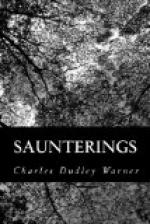It happened to be a rainy day, and cold, on the 30th of July, when we left Augsburg; and the flat fields through which we passed were uninviting under the gray light. Large flocks of geese were feeding on the windy plains, tended by boys and women, who are the living fences of this country. I no longer wonder at the number of feather-beds at the inns, under which we are apparently expected to sleep even in the warmest nights. Shepherds with the regulation crooks also were watching herds of sheep. Here and there a cluster of red-roofed houses were huddled together into a village, and in all directions rose tapering spires. Especially we marked the steeple of Blenheim, where Jack Churchill won the name for his magnificent country-seat, early in the eighteenth century. All this plain where the silly geese feed has been marched over and fought over by armies time and again. We effect the passage of, the Danube without difficulty, and on to Harburg, a little town of little red houses, inhabited principally by Jews, huddled under a rocky ridge, upon the summit of which is a picturesque medieval castle, with many towers and turrets, in as perfect preservation as when feudal flags floated over it. And so on, slowly, with long stops at many stations, to give opportunity, I suppose, for the honest passengers to take in supplies of beer and sausages, to Nuremberg.
A CITY LIVING ON THE PAST
Nuremberg, or Nurnberg, was built, I believe, about the beginning of time. At least, in an old black-letter history of the city which I have seen, illustrated with powerful wood-cuts, the first representation is that of the creation of the world, which is immediately followed by another of Nuremberg. No one who visits it is likely to dispute its antiquity. “Nobody ever goes to Nuremberg but Americans,” said a cynical British officer at Chamouny; “but they always go there. I never saw an American who had n’t been or was not going to Nuremberg.” Well, I suppose they wish to see the oldest-looking, and, next to a true Briton on his travels, the oddest thing on the Continent. The city lives in the past still, and on its memories, keeping its old walls and moat entire, and nearly fourscore wall-towers, in stern array. But grass grows in the moat, fruit trees thrive there, and vines clamber on the walls. One wanders about in the queer streets with the feeling of being transported back to the Middle Ages; but




